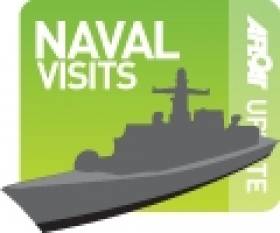Displaying items by tag: Belfast Tall Ships
#RoyalFrigate – A Royal Navy frigate is joining in the Belfast Tall Ships Races Festival which has 45 tallships visiting the city including a record 17 of the largest 'A' Class full-rigged vessels, writes Jehan Ashmore.
The Type 23 Duke class frigate HMS Northumberland (F238) is berthed in Pollock Dock and will be open to the public at certain times.
When not tasked on deployments the frigate commissioned in 1994 is based in her homeport of Devon, Cornwall. She along with the impressive A class tallships and those of the B,C and D classes are visiting the city which is also hosting the Belfast Titanic Maritime Festival.
In addition to boarding the 133m frigate of course will be opportuity to step on the decks of the Tallships which are also berthed on the Lagan and close to the Belfast Titanic Quarter. Tallships of all sizes and from many nations are berthed. Among them is the Brazilian Navy's clipper Cisne Branco meaning the 'White Swan'.
Announcements regarding vessel opening times will be notified to visitors over the course of the four –day festival that began yesterday and continues to this Sunday 5 July.
A total of 500,000 visitors are expected to throng the city's quays and the shores of Belfast Lough notably for the festival's maritime spectacle of the Parade of Sail on the Sunday from 11am!
To see the list of all participating tallships, events and much more visit http://tallshipsbelfast.com/
50 Days to Go Until Tall Ships Arrive on Belfast Lough
#BelfastTallShips – As of today, there are exactly 50 days to go until 50 of the world's finest Tall Ships begin to arrive on Belfast Lough.
Belfast Harbour will act as the home port before the start of the 2015 Tall Ships Race, with dozens of the world's majestic sailing vessels berthed in city over the weekend of July 2–5.
This is the third time that Belfast has welcomed the Tall Ships Race, having previously staged the event in 1991 and 2009. However, with the city acting as the staging post for the first leg of the race, even more ships will be taking part this year, with some 50 vessels – including 18 massive Class A ships – making the port their home for four days before setting off on their annual challenge.
More than 500,000 people are expected to attend the free event, bringing with them an economic windfall of at least £10 million for the city.
For further information on the events taking place over the weekend, the ships and where they will be berthed, the ancillary entertainments' programme, park and ride facilities and so on.
For info visit www.tallshipsbelfast.com






























































